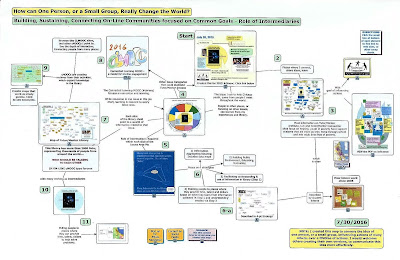You can find this and other ideas submitted by Kevin and #clmooc members in this G+ community and this Facebook community. You can find articles I've written about MOOCs and Learning on the side bar of this blog.
Below is a concept map I created this morning, showing how cMOOCs like this are needed in efforts to bring large groups of people together on an on-going basis to solve important local or global problems.
I titled it "How can One Person, or a Small Group, really change the world?"
In the concept map I point to the library of information and organizations that I've been building for more than 25 years. Below is just one map, representing one group of organizations.
This is a map showing organizations that work as intermediaries, connecting many other direct service organizations who focus on the well-being of youth in the Chicago region.
My vision is that I could click into the web site of any of these organizations, and find a section where they show how they are supporting on-line engagement of their members, and a blog that shows how important their role is in helping bring organizations, clients, resource providers together in on-line learning communities.
In another Storify, created a week ago after another #clmooc chat, Kevin shared Tweets around the "Who is here? Who is not?" topic (no longer available). When we talk about building communities, this needs to be part of the conversation.
As that happens, maps like mine begin to be connectors, or bridges, bringing people out of silos, into larger networks connecting more people from a single city, multiple cities, and multiple countries, who are concerned with the same problem.
There's much to do to make this happen.
Your first step is to click through the links and build your own understanding. You might even find an on-line group to join.











No comments:
Post a Comment